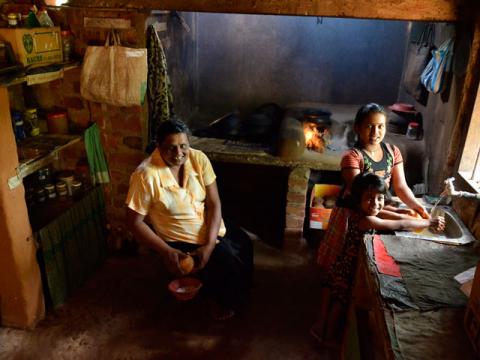Healthy kitchen, the heart of the home

In rural Sri Lanka, the kitchen is a place only for the mother. Only slightly taller than a playhouse and built separately from the house with walls of mud and thatched leaves for the roof, the kitchen was located at the back of the house.
“Everything was on the floor. The pots and pans, the bottles of spice, the firewood and the stove built with 3 rocks,” says Siriyawathi (45), “All the washing, cutting, chopping, cooking was done squatting on the floor.”
“I could multi-task – squatting there,” she says, “Check the food on the stove, add more firewood and prepare the next vegetable for cooking. But the smoke was always inside the kitchen and I smelt of smoke by the time I finished cooking.”
When the mother cooked and served everyone ate but no one knew if there was enough food for her. If the mother was not home, no one could cook because no one knew where everything was. That was the main reason fathers avoided the kitchen. The other reason was because they found it hard to operate squatting on the floor in one place and trying to multi task.
World Vision’s Healthy Kitchen Programme not only aimed at giving them healthy meals, but also a healthy family. The programme began by modifying their kitchen to have more space and order. The stove was built higher and a kitchen counter built into the wall would help them do their chopping and cutting while standing.
The smoke too had a passage to get out.
“The programme taught me how to keep a clean and a tidy kitchen.” says Siriyawathi, “I also learnt many healthy and hygienic practices such as washing hands properly before preparing food. It is no use having a clean water source if we don’t clean our hands before we start cooking. We also changed from our fascination for metal utensils and began using clay pots and pans which has no reactions to foods,”
“I have labelled all the bottles of spices and my husband enjoys cooking when I’m away,” she says, “My whole family participates in cooking now and it gives us a chance to spend time together.”
The programme also integrates home-gardening, waste management and compost production into it.
“Healthy Kitchen has also reduced what we usually spend on health every year. My family hardly falls sick now. Kitchen is the heart of our home. Even the visitors come straight to our kitchen,” says Siriyawathie.
With the whole family participating in preparation and sharing of meals, the healthy kitchen has helped in reducing domestic violence. The Programme that benefited over 1700 families has spread to almost every family with daughters taking after their mothers and carrying the healthy kitchen values to new families they build.